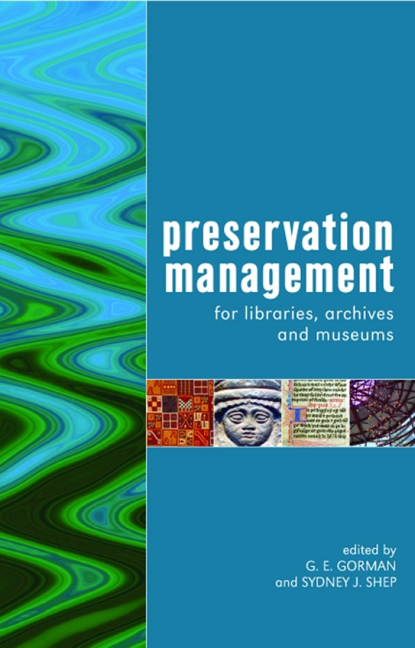Book contents
- Frontmatter
- Contents
- About the contributors
- Introduction
- 1 Managing the documentary heritage: issues for the present and future
- 2 Preservation policy and planning
- 3 Intangible heritage: museums and preservation
- 4 Surrogacy and the artefact
- 5 Moving with the times in search of permanence
- 6 Valuation model for paper conservation research: a new approach for setting research priorities
- 7 Preservation of audiovisual media: traditional to interactive formats
- 8 Challenges of managing the digitally born artefact
- 9 Preserving cultural heritage in times of conflict
- 10 Access and the social contract in memory institutions
- 11 Redefining ‘the collection’ in the 21st century
- Index
11 - Redefining ‘the collection’ in the 21st century
Published online by Cambridge University Press: 08 June 2018
- Frontmatter
- Contents
- About the contributors
- Introduction
- 1 Managing the documentary heritage: issues for the present and future
- 2 Preservation policy and planning
- 3 Intangible heritage: museums and preservation
- 4 Surrogacy and the artefact
- 5 Moving with the times in search of permanence
- 6 Valuation model for paper conservation research: a new approach for setting research priorities
- 7 Preservation of audiovisual media: traditional to interactive formats
- 8 Challenges of managing the digitally born artefact
- 9 Preserving cultural heritage in times of conflict
- 10 Access and the social contract in memory institutions
- 11 Redefining ‘the collection’ in the 21st century
- Index
Summary
Introduction
The development of preservation management strategies across a range of media forms has resulted in a reassessment of the nature and role of the collection. This chapter reviews the development of interest in preservation management and discusses current thinking on collection development and management in light of the, at times, conflicting needs of preservation and access, and as a result of digitization activity across the museum, library and archive sectors.
Primary emphasis on building collections
While preservation and the management of preservation activities have played a role in heritage institutions – libraries, archives and museums – throughout history, this role has ranged from passive to proactive. As far as we can determine, early libraries and archives existed to collect and protect heritage resources, but the protection was often an afterthought or side effect of the collecting urge. That is, these institutions saw their role primarily as custodians of materials, protecting them from the hoi polloi and from the vandals of the day.
This custodial function was essentially reactionary – keeping people and the elements away from whatever was in the collection. The great collections of the 18th and 19th centuries (the British Museum and the Bibliothèque Nationale are good examples) were primarily magnets for artefacts, which were stored and largely ignored. The story of the world's great libraries is primarily a story of collection building, and until perhaps the mid-20th century this is what libraries did: collected, processed and stored. And in libraries this was the term used: ‘collection building’. Whether we look at archives, libraries or museums, the urge to build seems to have been paramount until comparatively recently.
In the library world the emphasis on building began to wane after World War 2 and was gradually replaced by a more measured, ‘scientific’ approach that became known as collection development. This was an era in which collections were tailored more closely to their client base, and various benchmarking criteria were introduced, including Conspectus.
- Type
- Chapter
- Information
- Preservation Management for Libraries, Archives and Museums , pp. 182 - 194Publisher: FacetPrint publication year: 2006
- 1
- Cited by



